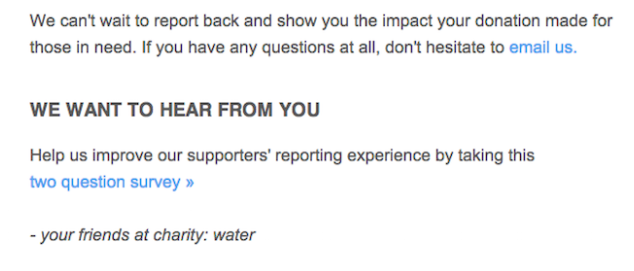15 Ways to Measurably Improve Your Ecommerce Program
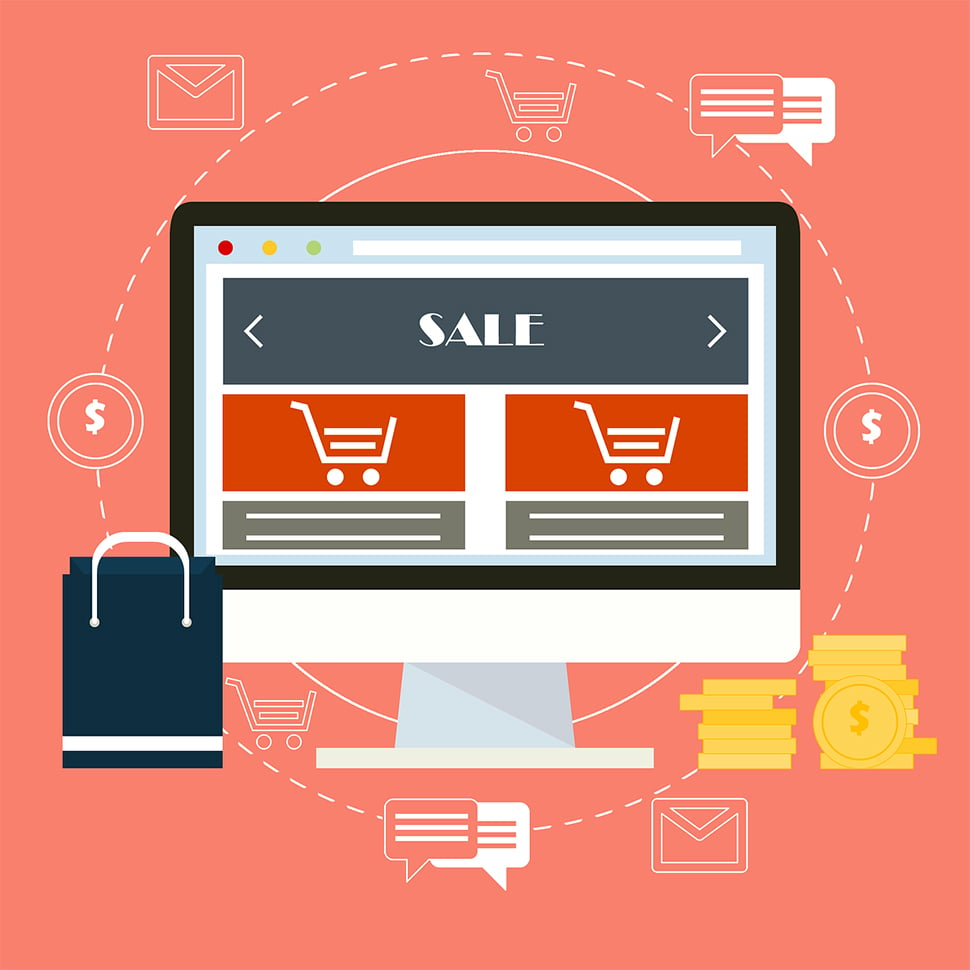
The father of modern management, Peter Drucker, is often quoted as saying, “What gets measured gets managed.”
Based on that point of view, it can also be said that what gets measured can be improved.
So if your ultimate goal is to improve your ecommerce experience, it makes sense to start with the metrics that can show you how you're performing at each stage in the customer journey.
While the list of KPI acronyms could fill a book, there are four that are critically important to any ecommerce business:
(1) CPL: Cost Per Lead
(2) CVR: Conversion Rate
(3) AOV: Average Order Value
(4) LTV: Customer Lifetime Value
Each of these metrics align well with the stages of the marketing flywheel (attract, engage, delight) and contribute in meaningful ways to the fundamental goal of any business: profitable growth.
Here, we'll list several specific tactics to improve your performance along each of these indicators.
I. Cost Per Lead
Lead generation can be defined in many ways, but the most common way to measure the profitability (and sustainability) of your top-of-funnel efforts is by evaluating the costs associated with acquiring a contact or account holder.
If you’re investing heavily in campaigns that yield little to no leads, it could be time to try one of these tactics designed to increase lead flow:
Contests
The theory behind contests (and content marketing in general) is that there is a value exchange that goes on between you (the business) and your prospective lead. Your prospect trades a chance at winning your awesome prize for their contact information, and voila: A lead is born.
Three keys to success with contests are (a) managing the ease of entry, (b) attracting the right type of leads, and (c) following up with them appropriately.
A great example of a brand contest done right is this one by Nations Photo Lab (NPL), a photo printing and gift retailer. Their best customers are “momtographers” and parents who love to take pictures of their kids.
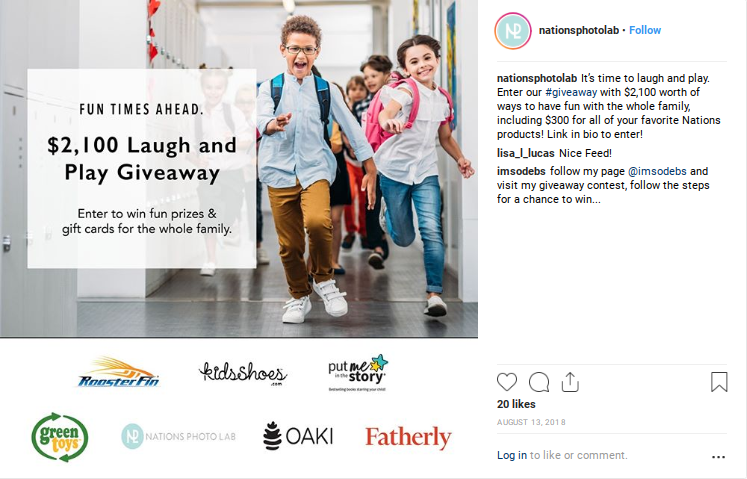 Instagram post from Nations Photo Lab.
Instagram post from Nations Photo Lab.
Entry via Instagram is quick and easy, and co-marketing their giveaway with brands that attract their ideal customer (toys, educational games, and other family lifestyle brands) means those who enter are likely to make a purchase from NPL, as well.
The follow-up after a contest is just as crucial as communication during the contest itself. What will motivate your captive audience to maintain interest in your brand and (eventually) make a purchase?
Seize the opportunity after a contest ends to offer an exclusive discount or relevant value-added content to those who entered, and continue to nurture them via email marketing and retargeting over time.
NPL ran this contest right before “back to school” time, when parents may be looking for a place to print their child’s school photos. You can bet the parents who entered this contest would be more than happy to take advantage of a well-timed discount on school prints or to learn more about the best “first day of school” photo techniques.
Events
While it may not be intuitive that events can yield low-cost leads, they can be an effective inbound marketing tactic for businesses of all sizes.
Rather than opting for a $15,000 booth at a trade show or sponsoring the city’s biggest holiday party, for instance, these small businesses partnered with a new apartment building in town to offer a pop-up shop for residents in the building and in the neighborhood.
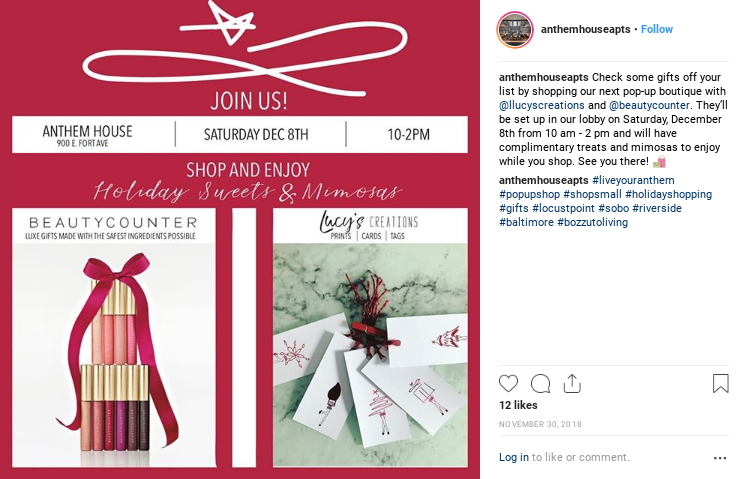 Instagram post from Anthem House Apartments.
Instagram post from Anthem House Apartments.
Building management benefits from offering a convenient holiday gift shopping experience to their residents and showing off the space to prospective tenants in the area. The retail geniuses at Beauty Counter and Lucy’s Creations gain access to a whole new audience of customers and future customers who may just stop by for sweets and mimosas. Meeting your leads where they are is a win for everyone involved.
Another benefit of experiential marketing is the word-of-mouth potential it creates. According to a study by the Event Marketing Institute, 73% percent of consumers post pictures of branded marketing events, and 49% share videos on social media.
Furthermore, 74% of those respondents say, “Engaging with branded event marketing experiences makes them more likely to buy the products being promoted in the future.”
Web personalization
For an ecommerce business, your website is your most important marketing channel. If you’re finding it challenging to turn anonymous website visitors into known leads, it may be because those visitors are expecting a more relevant, personalized experience.
Personalization takes customization (letting the user select a specific experience) one step further: It automatically changes the experience for a specific visitor based on who they are and why they’re visiting your website.
Change the copy, calls to action, imagery, layout, or navigation for your unknown website visitors based on geographic location, previous browsing history, gender identity, referral source, or even weather, like retailer Topshop did for visitors in rainy London:
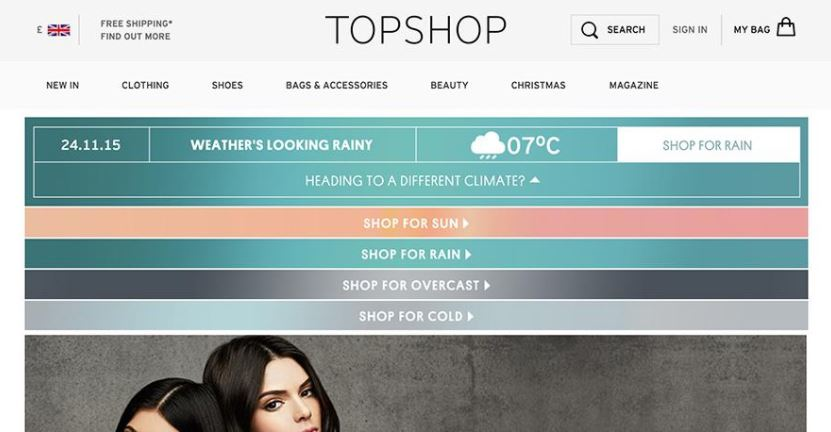 Topshop Europe website.
Topshop Europe website.
Looking for a software tool that facilitates this kind of personalization at scale? Try Certona, Dynamic Yield, Evergage, Google Optimize, or even HubSpot.
II. Conversion Rate
While almost all of the strategies discussed here can ultimately improve your ecommerce conversion rate, there are several that can have an immediately positive impact on your bottom line:
Dynamic retargeting
Many of today’s CMOs are wary of programmatic advertising, as it’s increasingly difficult to attribute the exact value of an impression in a customer’s multi-channel experience.
That being said, retargeting (or remarketing) is a highly relevant way to bring users who have already expressed interest in your products back to your site.
Typical retargeting, however, shows all (or a segment of) users the same branded image, regardless of what products they care about.
Dynamic retargeting shows people who have viewed specific content, left an item in their cart, or recently purchased a product the exact image, price, and/or description of what they’ve expressed interest in.
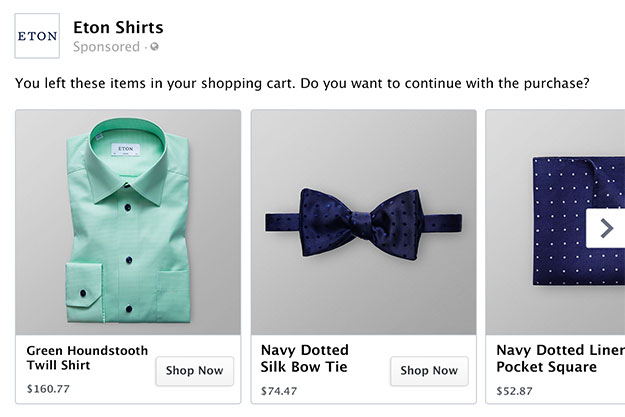 Ad by retailer Eton Shirts.
Ad by retailer Eton Shirts.
Google and Facebook both make it easy to scale your dynamic retargeting, by uploading your feed of products or service lines. They can also optimize the best product mix for each ad based on user data.
Plus, according to a recent WordStream study, remarketing conversion rates actually increase the more times users are served an ad, and dynamic retargeting ads fatigue at half the rate of non-retargeting display ads.
Live chat
If your product or service is one that is complex or expensive (and even if it’s not), providing instant access to your customer support team can mean the difference between a conversion and a lost sale.
Live chat is convenient, and getting your questions answered immediately is really satisfying. That’s why it works so incredibly well.
In one recent study, chat support increased conversion rates by an average of 40%, and according to Forrester Research, “44% of online customers report that having their questions answered by a live person while purchasing something is one of the most important features of a website.”
The keys to making the chat box work are using the right prompt, matching availability with peak traffic times, and having a well-prepared customer support team to handle customer inquiries.
Common questions about shipping, product features, or return policies can also inform your website content strategy and inspire investments in self-service channels in the future.
Website A/B testing
There are countless elements of a brand that contribute to a person choosing to make (or not make) a purchase. Some of those contributing factors, like your word-of-mouth reputation, your in-store experience, or your third party reviews, can't be easily be optimized with statistical precision.
But the elements that can be tested, measured, and optimized - should be.
That’s where A/B testing comes in. Running an A/B test (or “split” test) consists of choosing a single variable to test, identifying a KPI to measure success, showing a “control” and a test version of your variable to two equal segments of your audience sample, and interpreting the results.
When you think of all of the things on your website that can be tested (here’s a great list of them), getting started can feel overwhelming. That’s why, before investing in testing software, you need to create a plan.
The key to your ongoing testing plan is prioritization. Identify where the biggest opportunity lies within your user journey and optimize the elements that help you capitalize on that opportunity.
Optimizely has a great formula for prioritizing A/B tests, shown below.
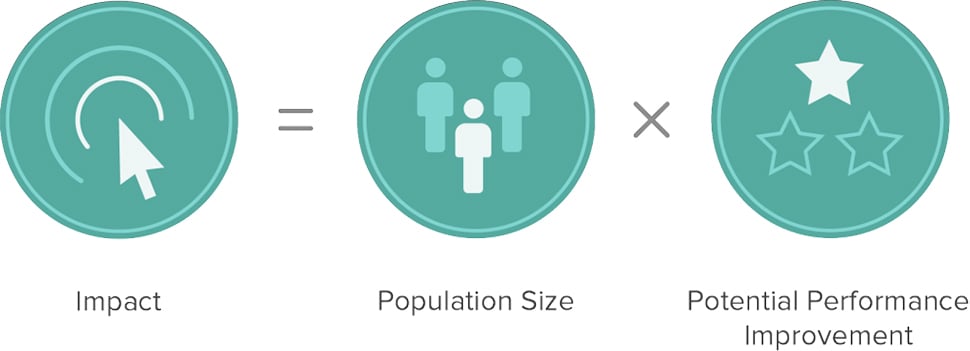 Optimizely's infographic for prioritizing A/B tests.
Optimizely's infographic for prioritizing A/B tests.
Using this formula, you can quantify the importance of your test by multiplying the potential number of visitors who would be impacted by the change by the predicted increase in conversion rate.
For instance, to calculate the value of a change to your shopping cart experience, you would multiply the number of users who enter your shopping cart in a given period by the conversion rate you predict will result from your change.
The resulting value will help you understand the value of your test relative to other tests in your plan.
Once you’ve prioritized your tests in order of importance, work with a tool like Optimizely, Google Optimize, or Unbounce to conduct the tests themselves.
III. Average Order Value
While it’s fairly intuitive that ecommerce businesses should be constantly working towards optimizing their conversion rates, it’s less obvious that a metric like average order value (AOV) can have an impact on their bottom line.
AOV (total revenue divided by number of orders), however, is an indicator that impacts everything from ad spend to product mix to pricing strategy.
Here are three ways to start moving the needle in the right direction:
Recommendation engines
According to Accenture, 75% of customers are more likely to make an online purchase based on personalized recommendations. That means that highlighting relevant products based on user data is a much more effective technique than simply showcasing your best-sellers.
In addition to being personalized, your recommendations should increase the number of items purchased and the frequency with which higher-margin items are sold.
In the absence of the gold standard algorithm used by the recommendation geniuses at Netflix, there are several tools that combine both user behavior information and what recommendation tool Barilliance calls “collaborative filtering.”
This ensures that a user sees recommendations that are relevant to their interests, complement the product they’ve added to their cart, and drive revenue for your business.
Besides Barilliance, AI product recommendation plugins are available for many ecommerce platforms (like Magento and Shopify), and are a common feature of most website personalization tools.
It’s important to note that a recommendation engine is worth testing and optimizing over time. Adding another step before completing a purchase may put your conversion rate at risk, so make your recommendations as relevant and as timely as possible.
Customer Success "Recipes"
It’s widely accepted that, when executed correctly, product bundling is an effective growth strategy. Commonly utilized in software sales, selling multiple products or services as one unit for a higher price (as opposed to selling them individually) is sometimes convenient for the customer, as well.
For many ecommerce companies, however, customers may not see the value of purchasing a suite of products at once. They also may not see the value in purchasing more than one product from you - even if they're complementary to one another.
That’s where value-based selling comes in.
Value-based selling is a strategy that focuses on demonstrating the ultimate value your products or services will create for your customer, and then packaging and pricing your product units accordingly.
A great way to demonstrate the value of using several of your products is by featuring multiple products in your testimonials or case studies and demonstrating how each product contributed to the user’s success.
Your customer stories should position several of your products as the "ingredients" that make up your "recipe" for success.
This concept is at the core of cosmetics company IT Cosmetics’ business strategy. The company's testimonials (including their founder’s), start with a problem faced by their audience and then list the "ingredients" (products) they used to overcome that problem.
Here’s a great testimonial that does just that:
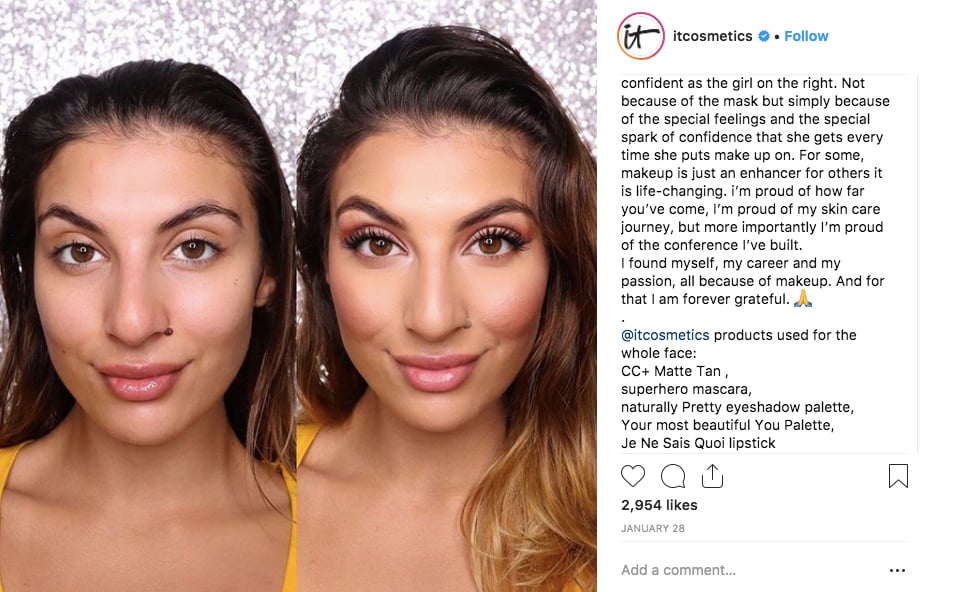 Instagram post from It Cosmetics.
Instagram post from It Cosmetics.
The value of this product assortment is clear: confidence and self-esteem. How to achieve that level of confidence and self-esteem is also made clear: the product mix listed in her post. This makes a strong, authentic case for purchasing multiple products (instead of one) to achieve the results shown above.
Another example of this concept in action is this Instagram post from Australian retailer Birdsnest:
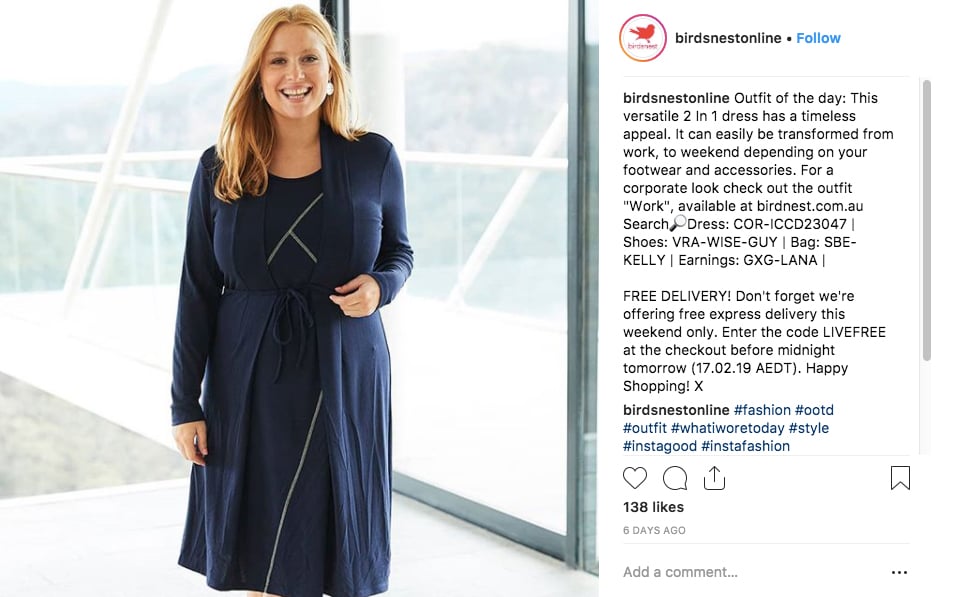 Instagram post from Birdsnest.
Instagram post from Birdsnest.
While each piece of this woman’s outfit is sold separately, they’ve presented them together, as a package. By demonstrating the impact of the entire outfit put together (as opposed to showcasing each piece individually), they’re more likely to sell multiple pieces within the same order.
Birdsnest continues this emphasis on a bundled sale on their website, where they sell curated collections as “outfits,” taking the guesswork out of achieving the looks showcased on their social media channels.
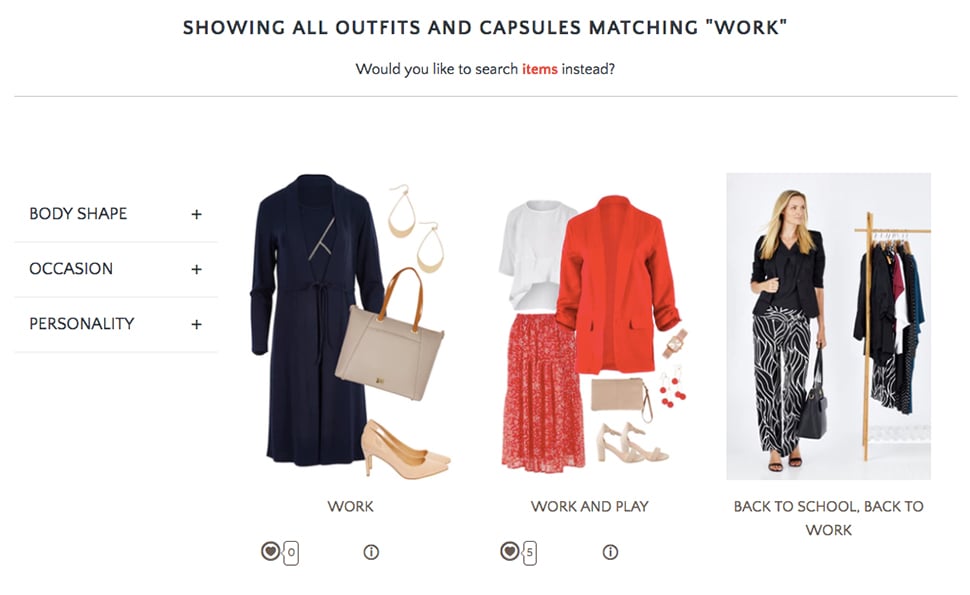 Birdsnest's website.
Birdsnest's website.
Thanks to this shift in strategy, they’ve grown from a five-person company to 140 employees in just five years.
Free shipping thresholds
Today’s buyers don’t just want free shipping; they expect it. Those expectations are shaped by retailers like Amazon Prime and WalMart, where regular and expedited shipping options are completely free of charge.
That being said, for some retailers, free shipping for every product all the time doesn’t make financial sense.
Luckily, setting a minimum value at which orders will ship for free is a proven way to increase average order value. Some compelling reasons to try it:
- Orders that qualify for free shipping average approximately 30% higher in value than those that do not.
- Faced with a free shipping threshold, 58% of buyers will add items to their cart to qualify for free shipping. Another 31% will join a loyalty program to qualify, and yet another 16% will purchase a higher-priced product that brings them above the free shipping threshold.
- 61% (more than half!) of consumers will cancel a purchase if there is no free shipping option.
Remember the formula for estimating the value of your A/B test? You can estimate and measure the effect of a free shipping minimum in a similar way:
Change in profit from free shipping minimum = [Increase in conversion rate] x [increase in average order value] x [change in profit margin]
Here’s an example of how Macy’s increases order value by showing the customer how close they are to the free shipping threshold in the cart:
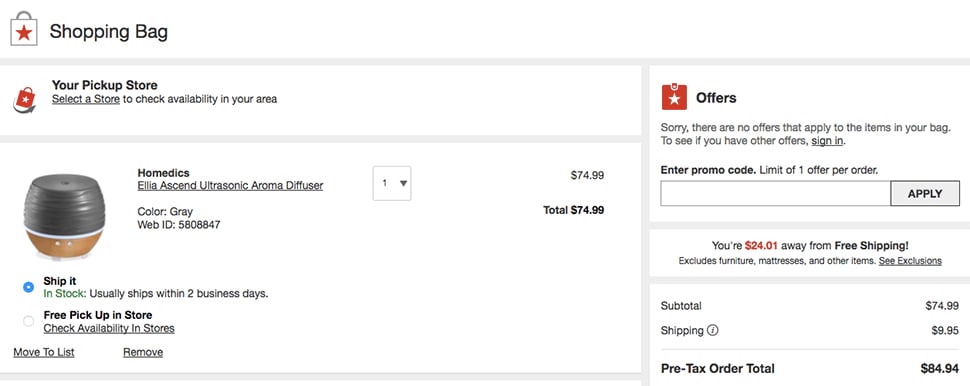 Macy's website.
Macy's website.
At this point, shipping costs are almost half of the spend required to unlock free shipping, so there’s a compelling reason to add another product to the order (hello, recommendation engine) before checking out.
IV. Customer Lifetime Value
If nothing (or not much) comes to mind when you’re asked about what steps you’re taking to increase customer lifetime value (a measurement of retention), you’re not alone. A recent survey found that only 40% of companies place as much emphasis on retention as they do on customer acquisition.
Companies that do focus on improving customer lifetime value, however, are at a distinct advantage. Acquiring a new customer is five times more expensive than retaining an existing one.
Here are three ways to maximize your relationship with existing customers and retain them long-term:
Reactivation campaigns
Unless your users are on a subscription plan, it’s unlikely that they’re making a purchase from you on a regular basis. If it’s been awhile since their last transaction, it doesn’t necessarily mean they’ve moved on entirely.
A reactivation campaign is designed to re-engage with old customers or with customers who purchased before, but haven’t visited your site recently. According to ReturnPath, 25-50% of most businesses’ subscriber lists are classified as “inactive.”
Why not win back some of those folks who have already moved through the purchase process once with an automated email campaign?
Using a marketing automation tool such as HubSpot, create an email campaign triggered by inactivity that (a) incentivizes old customers to see what’s new or make another purchase (b) shares compelling content from your blog or YouTube channel, or (c) solicits feedback from your customer base to help improve their experience.
This email from personalized gift source Mark and Graham does a great job incentivizing a dormant customer to give them another try.
.png?width=393&name=unnamed%20(1).png) Email from Mark and Graham.
Email from Mark and Graham.
Another great example of automated reactivation comes from Charity: Water, an international nonprofit dedicated to ending the water crisis in developing countries. By triggering an email update to a one-time donor (shown below), they can showcase the impact of their donation and encourage another.
Even better, they use this touchpoint (9-12 months after the initial donation) to request feedback from the donor, making this touchpoint one that re-engages in a truly meaningful way.
Loyalty programming
While the punch card and the coupon have been staples of the brick-and-mortar shopping experience for decades, there’s a reason why loyalty programs make sense for ecommerce companies, as well:
Loyal customers spend up to 67% more than new ones and 78% of loyal customers are willing to share their positive experience with their network.
Initiating and expanding a loyalty program is a way to identify and reward your best customers. In a world where the “80/20 rule” still very much applies (80% of revenue comes from 20% of your customer base), this is a great way to understand your ideal customer profile, encourage repeat purchases, and improve word-of-mouth reach.
The challenge is creating a program that your customers actually use. 90% of retailers have some kind of loyalty program in place, but consumers only participate in half of the programs they belong to.
Outdoor gear company The North Face has a successful, multi-channel loyalty program called VIPeak. Joining is simple (and can be done online, in a store, or via the mobile app), the points system is intuitive, and rewards can be redeemed via any shopping channel.
.png?width=752&name=unnamed%20(2).png) The North Face's VIPeak loyalty program promotion.
The North Face's VIPeak loyalty program promotion.
78% of consumers prefer instant access to their rewards, and 80% are more likely to patronize a brand if it offers them a personalized experience. Connecting the rewards program to their mobile application increases the convenience of the program and allows North Face to deliver relevant offers that their audience is likely to use at the point of sale.
Take customer service company-wide
A recent Zendesk survey found that 63% of consumers expect to have a choice of channels through which they can receive immediate support from a brand, and 34% preferred social media to traditional contact methods like phone and email.
Furthermore, 50% of customers expected brands to have access to any previous conversations between themselves and the company, regardless of who’s fielding their inquiries.
Rather than perceiving this is a challenge, ecommerce brands should see this expectation for omnichannel support as an opportunity to delight your customers at every touchpoint.
Zappos, for example, created a dedicated Twitter account for customer service inquiries. Instead of funneling customers to their contact form or to a robotic phone line, most of the inquiries are addressed fully on the channel through which they were received.
Their quick response time and their 100% response rate pays off. 75% of their purchases come from returning customers and 43% of new customers hear about the company from a friend, family member, or coworker.
If it doesn’t make sense to create a separate service channel for your customers, invest in training those responsible for any customer touchpoint to field, respond to, and follow up with customer inquiries effectively. Define your brand voice and evaluate your team members’ tone when interacting with customers.
How can you build customer delight into how your team members are evaluated? What examples of successful interactions can you share with new employees? What types of customer inquiries should every employee understand how to handle?
Helping your customers solve problems is more than a “nice to have;” it’s an imperative. People who had a bad customer service experience are 50% more likely to discuss it on social media than those who didn’t.
Make the Most of Your Ecommerce Experience
Whether you’re selling handmade items on Etsy, collecting donations for your nonprofit organization, or scaling your global software business, your customers’ expectations for their ecommerce experience are sky-high.
Optimizing each stage of your customer experience puts you one step closer to achieving a competitive advantage.
Are you looking for expert advice about how to grow your ecommerce business? We can help you evaluate your KPIs and create and implement the plan that aligns best with your organization. Drop us a line and we'll get started.

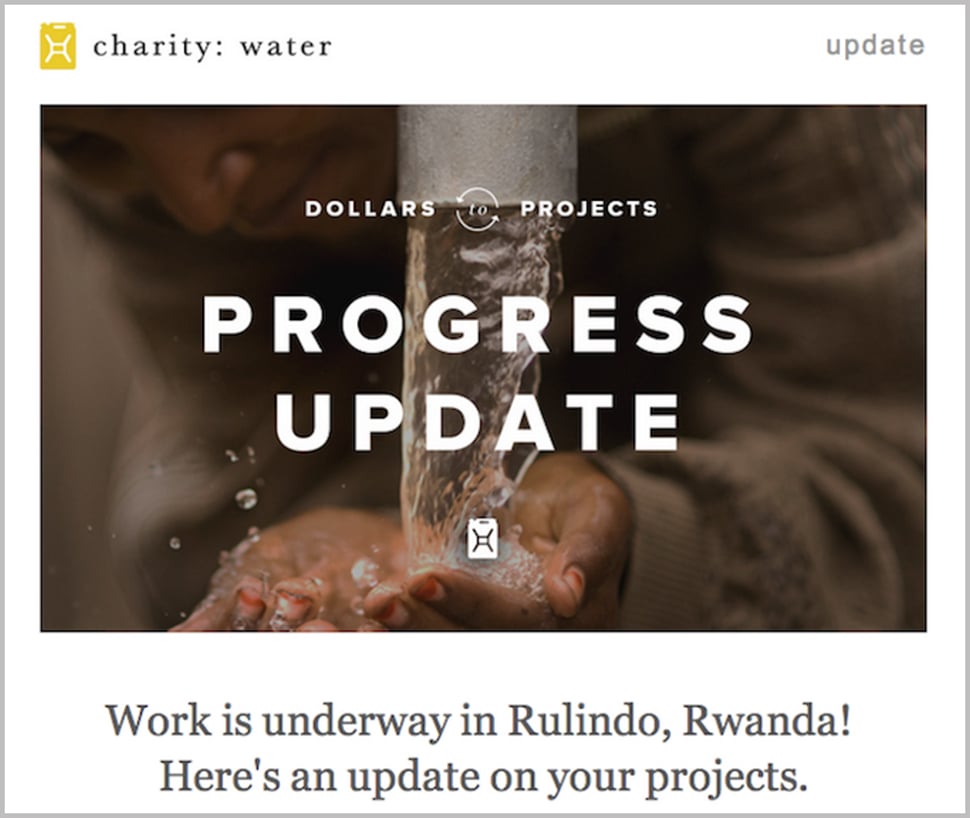
-1.png?width=695&name=unnamed%20(1)-1.png)
